The leaf eating black headed caterpillar, Opisina arenosella is a serious pest of coconut palm causing significant yield loss in all the coconut growing tracts of India. It infests coconut of all age groups and is a prolific feeder of coconut leaves. On the adult palms, the infestation starts on the outer whorls of leaves and due to the feeding damage the photosynthetic efficiency especially of the lower fronds will be impaired and in severe cases, whole plantation presents a burnt up appearance due to the drying of leaves. In case of severe out breaks the attacked leaves droop, bunches buckle and the immature nuts are shed heavily, in extreme cases feeding by the caterpillar on the green nut surface is also observed.
Severe incidence of O. arenosella in coastal Andhra Pradesh during 2015-16
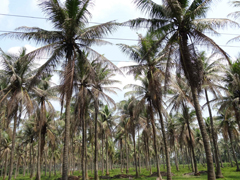
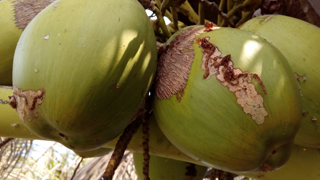
वर्ष 2015-16 (अक्तूबर से मई) में आन्ध्र प्रदेश के सभी तटवर्ती जिलों में काले सिर वाले कैटरपिल्लर का उच्च संक्रमण देखने को मिला और यह प्रकोप 42.8 से 62.9 प्रतिशत दर्ज किया गया। काले सिर वाले कैटरपिल्लर का प्रकोप आन्ध्र प्रदेश के पूर्वी गोदावरी जिले के अल्लावरम मण्डल में अधिक (लगभग 675 हे. रकबा प्रभावित) और नारियल की खेती करने वाले मण्डल यथा कटरेनिकोना, राजोल, उप्पलागुप्टम (लगभग 300 हे. रकबा प्रभावित) में मध्यम सघनीय नुकसान पाया गया।
जैव नियंत्रण
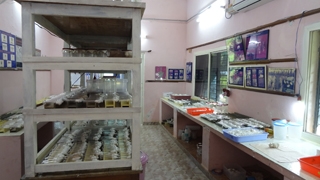
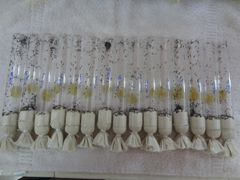
काले सिर वाले कैटरपिल्लर के लार्वा परजीव्याभ यथा ब्रेकन हेबेटर और गोनियोजस नेफान्टिडिस कीट नाशीजीवों की रोकथाम करने में प्रभावी पाए गए। इस प्रकोप को निकटवर्ती नारियल की खेती वाले मण्डलों में रोकने के लिए और संक्रमित गांवों में नाशीजीव संख्या को कम करने के लिए डॉ. वाई.एस.आर. बागवानी विश्वविद्यालय; बागवानी विभाग, आन्ध्र प्रदेश सरकार के अंतर्गत कार्यरत अखिल भारतीय समन्वित ताड़ अनुसंधान परियोजना, अम्बाजीपेटा के अधीन बागवानी अनुसंधान केन्द्र और मैसर्स नोवियल कोकोनट प्रोड्यूसर कम्पनी ने नारियल विकास बोर्ड, कोच्चि की वित्तीय सहायता से साथ मिलकर इस प्रकोप को रोकने की योजना बनाई जिसे समुदाय आधारित पादप संरक्षण गतिविधियां LODP स्कीम के तहत किया गया। अक्तूबर, 2015 से अप्रैल, 2016 तक प्रभावित मण्डलों में नाशीजीव से संक्रमित बगीचों में वितरण एवं जारी करने के प्रयोजन से HRS., अम्बाजीपेटा स्थित जैव नियंत्रण प्रयोगशाला में लगभग 37,88,650 परजीव्याभ उत्पन्न किए गए।
जारी तकनीक
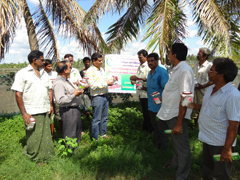
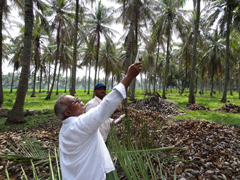
आमतौर पर, कम (यहां-वहां कुछ क्षतिग्रस्त पत्तियां) से मध्यम ( स्पष्ट शुष्कन के साथ 2 – 3 अपुष्प-पर्ण) सघनता नुकसान के मामले में 15 दिन के अन्तराल पर प्रत्येक गांव में संक्रमित ताड़ के कम से कम दस प्रतिशत में परजीव्याभ जी. नेफान्टिडिस को 10 परजीव्याभ/ताड़ की दर पर छोड़ा जाता है जबकि बी. हेबेटोरैट को 20 परजीव्याभ/ताड़ की दर पर छोड़ा जाता है। लेकिन वहां उच्च सघनता (पत्तियों के सभी निचले अपुष्प पर्ण अथवा सम्पूर्ण शीर्ष नुकसानग्रस्त) पाए जाने पर परजीव्याभ को कहीं अधिक मात्रा में छोड़ा गया। बागवानी विभाग और नोवियल कोकोनट प्रोड्यूसर कम्पनी के तहत गठित कोकोनट प्रोड्यूसर सोसायटीज की सहायता से किसानों को नाशीजीव की पहचान, नुकसान की प्रकृति और जैव नियंत्रण के माध्यम से काले सिर वाले कैटरपिल्लर की रोकथाम तथा खेत दौरों के माध्यम से परजीव्याभ छोड़ने, ग्राम बैठकों, समूह चर्चा और प्रेस कवरेज पर जागरूक बनाया गया। नाशीजीव से संक्रमित गांवों में नियमित खेत दौरा करने और लार्वा अवस्था आधारित परजीव्याभ को छोड़ने पर सूचना का प्रसार करने से किसान समुदाय में जागरूकता उत्पन्न की गई जिसमें प्रभावित बगीचों में छोड़े गए परजीव्याभ की प्रभावी मॉनीटरिंग और समय-सारणी पर जानकारी शामिल थी। प्रत्येक प्रभावित गांव में परजीव्याभ को 8 – 12 बार छोड़ा गया।
.
परजीव्याभ स्थापना एवं नाशीजीव नियंत्रण
नाशीजीव प्रभावित बगीचों में इन प्राकृतिक शत्रुओं की स्थापना और निर्माण अथवा गठन की पुष्टि करने के प्रयोजन से नाशीजीव प्रभावित इलाकों (10 प्रतिशत नमूना ताड़) में यादृच्छिक रूप से परजीव्याभ वसूली अध्ययन किए गए। जैव एजेन्टों को जारी करने के तीसरे और छठे माह के बाद परजीव्याभ स्थापना पर संकलित आंकड़ों से पता चला कि प्रभावित बगीचों में प्राकृतिक शत्रु अच्छी तरह से स्थापित हुए और जैव एजेन्टों द्वारा प्रभावी ढ़ंग से ऑपीसिना अरेनोसेला कैटरपिल्लर को बाधित किया गया। नाशीजीव संख्या में परजीव्याभ छोड़ने के बाद तीव्र गिरावट देखने को मिली। प्रभावित बगीचों में ऑपीसिना अरेनोसेला की लार्वा संख्या में परजीव्याभ को जारी करने के तीन माह बाद एवं छ: माह बाद क्रमश: 34.1 से 75.9 प्रतिशत एवं 59.6 से 100.00 प्रतिशत तक कमी आई और नई निकली पत्तियों में कोई पत्ती नुकसान तथा नाशीजीव संख्या दर्ज नहीं की गई। नाशीजीव की प्यूपा संख्या में छ: माह बाद 33.3 से 94.5 प्रतिशत और 92.8 से 100.0 प्रतिशत तक कमी देखने को मिली।
पर्यावरणीय अनुकूल एवं वित्तीय लाभ
 छ: माह के बाद नाशीजीव से प्रभावित गांवों में जैविक नियंत्रण का प्रभाव साफ तौर पर देखा गया। जैव नियंत्रण एजेन्टों को प्रचुर मात्रा में जारी करने से नाशीजीव की लार्वा अवस्था को सफलतापूर्वक नियंत्रित किया गया और काले सिर वाले कैटरपिल्लर से संक्रमित सभी बगीचों में इनकी संख्या में पर्याप्त गिरावट आई। स्वत: स्थिर परजीव्याभ द्वारा अन्य मण्डलों में प्रकोप को फैलने से रोका गया और सरकारी संगठनों के संयुक्त प्रयासों से किसानों को नारियल इकोसिस्टम में नुकसानदायक कीटनाशकों मोनोक्रोटोफॉस तथा डाइक्लोरोवास का इस्तेमाल करने से किसानों को अलग किया गया । जैव नियंत्रण में शामिल लागत रूपये 20.06 लाख थी और रासायनिक हस्तक्षेप की परिकल्पित लागत को यदि रूपये 63.18 लाख (975 हे. क्षेत्र) माना जाता है। वहां रूपये 43.12 लाख की बचत थी और साथ में ऑपरेशन में स्वत: नियंत्रित जैविक नियंत्रण के साथ निर्बाध प्राकृतिक इकोसिस्टम का चक्रीय लाभ भी मिला। आजकल जहां नुकसानदायक कीटनाशकों का प्रयोग चिंता का विषय बन रहा है, वैकल्पिक प्रणाली के रूप में जैविक नियंत्रण की यह सफलता टिकाऊ कृषि को नया सम्बल देती है।
छ: माह के बाद नाशीजीव से प्रभावित गांवों में जैविक नियंत्रण का प्रभाव साफ तौर पर देखा गया। जैव नियंत्रण एजेन्टों को प्रचुर मात्रा में जारी करने से नाशीजीव की लार्वा अवस्था को सफलतापूर्वक नियंत्रित किया गया और काले सिर वाले कैटरपिल्लर से संक्रमित सभी बगीचों में इनकी संख्या में पर्याप्त गिरावट आई। स्वत: स्थिर परजीव्याभ द्वारा अन्य मण्डलों में प्रकोप को फैलने से रोका गया और सरकारी संगठनों के संयुक्त प्रयासों से किसानों को नारियल इकोसिस्टम में नुकसानदायक कीटनाशकों मोनोक्रोटोफॉस तथा डाइक्लोरोवास का इस्तेमाल करने से किसानों को अलग किया गया । जैव नियंत्रण में शामिल लागत रूपये 20.06 लाख थी और रासायनिक हस्तक्षेप की परिकल्पित लागत को यदि रूपये 63.18 लाख (975 हे. क्षेत्र) माना जाता है। वहां रूपये 43.12 लाख की बचत थी और साथ में ऑपरेशन में स्वत: नियंत्रित जैविक नियंत्रण के साथ निर्बाध प्राकृतिक इकोसिस्टम का चक्रीय लाभ भी मिला। आजकल जहां नुकसानदायक कीटनाशकों का प्रयोग चिंता का विषय बन रहा है, वैकल्पिक प्रणाली के रूप में जैविक नियंत्रण की यह सफलता टिकाऊ कृषि को नया सम्बल देती है।
(स्रोत : भाकृअनुप – अखिल भारतीय समन्वित ताड़ अनुसंधान परियोजना, भाकृअनुप – केन्द्रीय रोपण फसल अनुसंधान संस्थान (ICAR-CPCRI), कासरगोड)
ONTROL-01-20042017.jpg" title="Community based bio control of coconut black headed caterpillar" width="240" height="180" alt="Community based bio control of coconut black headed caterpillar" />
In 2015-16 (October to May), a high infestation of black headed caterpillar was observed in all the coastal districts of A.P and incidence ranging from 42.8 to was 62.9 per cent was recorded. An outbreak of black headed caterpillar was recorded in Allavaram mandal (approximate acreage affected is 675 ha) and a medium intensity damage was observed in other coconut growing mandals viz., Katrenikona, Razole, Uppalaguptam mandals (approximate acreage affected is 300 ha) in Konaseema region of East Godavari district of Andhra Pradesh.
Biocontrol
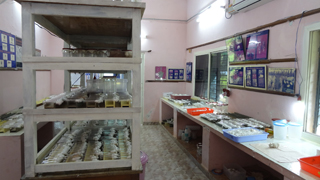
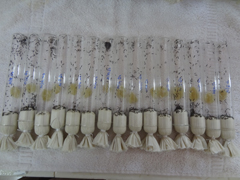
The larval parasitoids of black headed caterpillar viz.,Bracon hebetor and Goniozus nephantidis are found effective in managing the insect pest. In order to contain the outbreak from spreading to neighboring coconut growing mandals and to reduce the pest population in affected villages, Horticultural Research Station under the AICRP on Palms, Ambajipeta working under Dr YSR Horticultural University; Department of Horticulture, Government of Andhra Pradesh and M/s Noveeal Coconut producer company together planned to manage the outbreak with the financial assistance of Coconut Development Board, Kochi under community based plant protection activities LODP scheme. From October 2015 to April 2016 about 37,88,650 numbers of these parasitoids were produced in bio-control lab. at HRS., Ambajipeta for distribution and release in pest affected gardens in the affected mandals.
Release technique
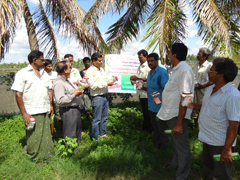
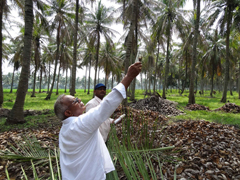
Usually the parasitoids G. nephantidis are to be released at the rate of 10 parasitoid/palm and B. hebetor at the rate of 20 parasitoid /palm in at least ten per cent of the infested palms in each village at fortnightly intervals in case of low (few damaged leaflets here and there) to medium (2–3 damaged fronds with clear drying) intensity damage. But as there is high intensity (all the lower whorls of leaves or entire crown damaged) inundative release of parasitoids was taken up. With the assistance of department of Horticulture and coconut producer societies formed under the Noveeal Coconut producer company the farmers were sensitized on pest identification, nature of damage and management of black headed caterpillar through bio-control and parasitoid release through field visits, village meetings, group discussions and press coverage. Regular field visits to pest affected villages and dissemination of information on larval stage based parasitoid release created awareness in the farmers community on effective monitoring and scheduling of parasitoid release in the affected gardens. A total of 8-12 release of parasitoids were made in each affected villages.
Parasitoid establishment and pest regulation
The parasitoid recovery studies were also undertaken randomly in the pest affected areas (10% sample palms) to ascertain the establishment and build up of these natural enemies in the pest affected gardens. Data on parasitoid establishment after third and six months of bio agents release revealed that the natural enemies established well in the affected gardens and bio-agents effectively paralysed O. arenosella caterpillars. The pest population showed a sharp decline after the parasitoid release. The larval population of O. arenosella in the affected gardens decreased by 34.1 to 75.9 per cent after three months and up to 59.6 to 100.0 per cent after six months of release of parasitoids and no leaf damage and pest population was recorded in the newly emerged leaves. The pupal population of the pest has also decreased by to 33.3 to 94.5 per cent and up to 92.8 to 100.0 after six months.
Eco-friendly and monetary benefit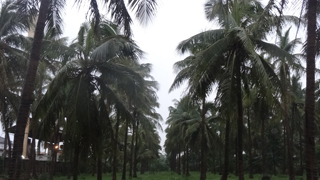 The impact of biological control was clearly evident in the pest affected villages after six months. The inundative release of bio-control agents successfully regulated the larval stage of pest and the population dwindled and came down substantially in all the black headed caterpillar affected gardens. The self perpetuating parasitoids prevented the spread of the out break to other mandals and the joint efforts of the government organisations weaned and prevented the farmers from resorting top the use of hazardous insecticides monocrotophos and dichlorovas in the coconut ecosystem. The cost involved in bio-control was Rs 20.06 lakhs and the assumed cost of chemical intervention if resorted is Rs 63.18 lakhs (for 975 ha area). There was a saving of Rs 43.12 lakhs with compounded benefit of undisturbed natural ecosystem with self regulating biological control in operation. In the days where hazardous pesticides usage is becoming a matter of concern, this success of biological control as a alternate system, gives impetus to sustainable agriculture.
The impact of biological control was clearly evident in the pest affected villages after six months. The inundative release of bio-control agents successfully regulated the larval stage of pest and the population dwindled and came down substantially in all the black headed caterpillar affected gardens. The self perpetuating parasitoids prevented the spread of the out break to other mandals and the joint efforts of the government organisations weaned and prevented the farmers from resorting top the use of hazardous insecticides monocrotophos and dichlorovas in the coconut ecosystem. The cost involved in bio-control was Rs 20.06 lakhs and the assumed cost of chemical intervention if resorted is Rs 63.18 lakhs (for 975 ha area). There was a saving of Rs 43.12 lakhs with compounded benefit of undisturbed natural ecosystem with self regulating biological control in operation. In the days where hazardous pesticides usage is becoming a matter of concern, this success of biological control as a alternate system, gives impetus to sustainable agriculture.
(Source: ICAR-AICRP on Palms, ICAR-CPCRI, Kasaragod)







फेसबुक पर लाइक करें
यूट्यूब पर सदस्यता लें
X पर फॉलो करना X
इंस्टाग्राम पर लाइक करें